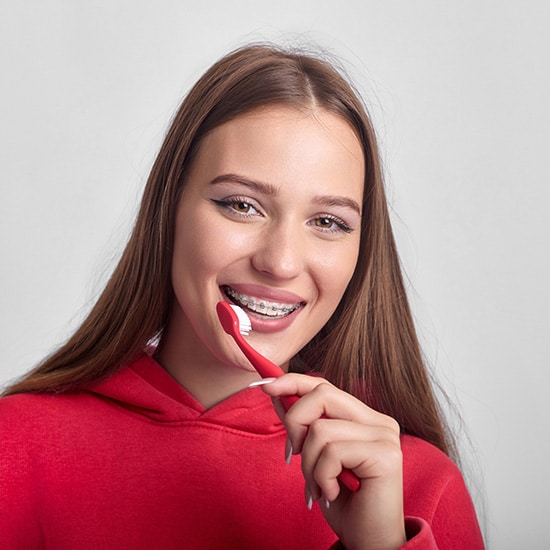Brushing and Flossing
It’s more important than ever to brush and floss regularly when you have braces so the teeth and gums are healthy during orthodontic treatment. Patients who do not keep their teeth clean may require more frequent visits to the dentist for a professional cleaning. Adults who have a history of gum disease should also see a periodontist during orthodontic treatment.
Watch the two videos below on the proper care of braces during orthodontic treatment.
Oral Hygiene Aides
- Sonicare Toothbrush
- Waterpik
- Prescription Fluoride toothpaste
- ACT Fluoride Rinse
- Glide Threader Floss
Eating with Braces
What can you eat? Let’s talk about what you shouldn’t eat! For the first day or so, stick to soft foods. Avoid tough meats, hard breads, and raw vegetables. Before long, you’ll be able to bite a cucumber again. But you’ll need to protect your orthodontic appliances when you eat for as long as you’re wearing braces.
Foods to Avoid
- Chewy foods: bagels, hard rolls, licorice
- Crunchy foods: popcorn, ice
- Sticky foods: caramels, gum
- Hard foods: nuts, candy
- Foods you have to bite into: corn on the cob, apples, carrots. Cut up raw fruits and vegetables as needed.
- Chewing on hard things (for example, pens, pencils, or fingernails) can damage the braces. Damaged braces will cause treatment to take longer.
- Minimize sugar intake, especially sugary drinks! Be careful, as Gatorade is packed full of sugar. Drink more water.
- Gum – stay away from the regular gum (Bubble Yum), which sticks to brackets and wire. However, a half-stick of sugar-free gum is okay and is actually good for your teeth since it stimulates saliva production.
General Soreness
When you get your braces on, you may feel general soreness in your mouth and teeth may be tender to biting pressures for 3 – 5 days. Take Tylenol/Ibuprofen or whatever you normally take for headache or discomfort. The lips, cheeks, and tongue may also become irritated for one to two weeks as they toughen and become accustomed to the braces. We will supply wax to put on the braces in irritated areas to lessen discomfort.
Loosening of Teeth
This is to be expected throughout treatment. Don’t worry! It’s normal. Teeth must loosen first so they can move. The teeth will firm up in their new — corrected — positions after treatment is completed.
Loose Wire or Band
Don’t be alarmed if a wire or band comes loose. This happens occasionally. If a wire sticks out and is irritating, use a blunt instrument (eraser end of a pencil) and carefully, gently push the irritating wire back under the archwire. Simply get it out of the way. If irritation to the lips or mouth continues, place wax or wet cotton on the wire to reduce the annoyance. Call our office as soon as possible for an appointment to check and repair the problem.
Rubber Band Wear
To successfully complete orthodontic treatment, the patient must work together with the orthodontist. The teeth and jaws can only move toward their corrected positions if the patient consistently wears the rubber bands or other appliances as prescribed. Lack of cooperation following instructions and damaged appliances lengthen the treatment time. So please follow the instructions!
Athletics
If you play sports, it’s important you let us know. A protective mouthguard should be worn for playing contact sports.
We have SISU mouthguards available for purchase. These are thinner mouthguards that can be worn over braces and are easier to breathe with. However, we must form them for you, to prevents broken brackets.
